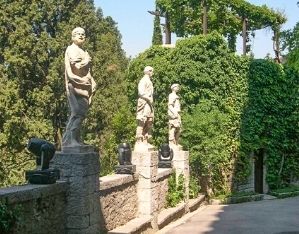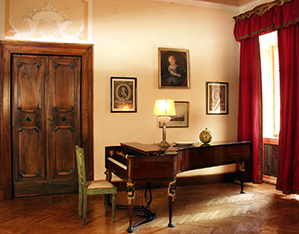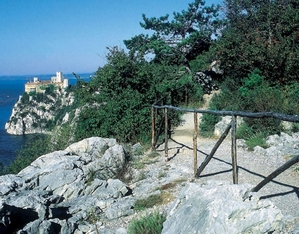An old castle overlooking the sea, set in a Mediterranean scrub landscape shaped by well-tended garden terracing. An evocative setting where human ingenuity enhances the powerful and rugged beauty of nature, a landscape that inspired Rilke to compose one of the literary masterpieces of the 20th century, his Duino Elegies.
On a steep promontory overlooking the Gulf of Trieste there is a many-times-remodelled 14th-century castle. All that remains of the ancient fortress are the striking ruins still standing on a rock emerging from the sea. Following the restoration of the walls and towers of the medieval manor in the early 19th century, in the second half of the same century the cultured princess and illustrious patron of the arts Marie von Thurn und Taxis began to create a park to enhance the natural qualities of the site. At that time, the park of Castello di Miramare for Archduke Maximilian of Habsburg was nearing completion. Half-destroyed during the First World War, the site was restored in the 1920s by Marie’s nephew Prince Raimondo who can be credited for the overall reorganisation of the area, dividing the park into terraces. The first area to be completed was the one around the castle and protected by Mediterranean scrub; Raimondo also added several “green rooms”, where a well-kept flora combines with sculptures, balustrades and stairs leading down to the sloping lower levels, enhanced by three belvederes overlooking the surrounding woodland vegetation. The princes, related to the most important ruling houses of Europe, currently still own the complex, with Carlo Alessandro, son and heir of Prince Raimondo, in charge of the management and maintenance of the park and of its floral and shrub vegetation. Castello di Duino is a unique location where human ingenuity enhances the powerful and rugged beauty of the environment.
Highlights

The avenue to the inner courtyard
A sequence of antique-style statues flanks the avenue leading into the castle’s inner courtyard, a space surrounded by the castle walls and its two crenelated towers.

Illustrious guests
Over the years Castello di Duino has welcomed many illustrious guests: composers Johann Strauss and Franz Liszt as well as other notable names such as Eleonora Duse, Paul Valery, Mark Twain, Gabriele D'Annunzio, and Hugo von Hofmannsthal. The personality whose name is most closely connected to this fascinating location is Rainer Maria Rilke, who in Castello di Duino began writing one of his masterpieces, the Duino Elegies.

Sentiero Rilke
This spectacular path dedicated to Rilke, inaugurated in 1987, has become a popular panoramic walk to the bay of Sistiana, with breathtaking views of the cliffs of the Regional Nature Reserve.
 Castello di Duino
Contacts
Castello di Duino
Contacts
Contacts
Telephone:+39 040 208120
Other contacts::Fax: 040 208022
Address
Frazione Duino, 32
34011, Duino (TS)
 Castello di Duino
Opening times and prices
Castello di Duino
Opening times and prices
Opening hours
The Castle of Duino is open:
- Mondays, Wednesdays, Thursdays and Fridays: 9.30 a.m. – 12.30 p.m.
- weekends and public holidays: 9.30 a.m. – 5.30 p.m.
- the Castle is closed on 25 December and 1 January.
From November to the first half of March:
- the Castle is open on weekends and holidays
- during the week, the Castle is open only by reservation for groups (with a minimum of 25 participants).
From mid-March until the end of October:
- the Old Castle is open on weekends.
- can also be open during the week on request depending on weather conditions.
Pricing
- Full price: € 8,00
- Reduced (over 65): € 6,00
- Reduced (7-14 years): € 4,00
- Students (with card): € 6,00
- Children (0-7 years): free admission
- Families (2 adults + 2 children): 1 child free entry
- Groups (25 people or more): € 6.00 per person
- Groups (minimum 10 people): € 7,00
The € 8.00 ticket allows access to the Castle, the Park and the Bunker.
The combined ticket € 10.00 allows access to the 11th century Old Castle, which can also be visited on its own (by purchasing a € 5.00 ticket).
 Castello di Duino
How to get there
Castello di Duino
How to get there
Address
Frazione Duino, 32
34011, Duino (TS)
Latitude: 45.774729
Longitude: 13.601365
How to arrive by road
From Trieste take Via Giosuè Carducci and Via Commerciale in the direction of Str. Nuova per Opicina/E61. Turn left and take Str. Nuova to Opicina/E61. Continue as far as Sgonico. Then enter E 70 and continue. Take the SS14 in the direction of Frazione Duino/SP2 in Duino and continue to Duino.
 Castello di Duino
Services/Accessibility
Castello di Duino
Services/Accessibility
Services
There is a souvenir shop in the Castle.
The Castle bar is located inside the park.
The Castle bar is located inside the park.
The Castle bar is located inside the park.
The Castle bar is located inside the park.
 Castello di Duino
Private events
Castello di Duino
Private events
Castello di Duino offers the possibility to organize private events such as weddings, gala dinners, corporate events, art exhibitions, photo and film shoots, cultural and musical events.
 Castello di Duino
Itineraries
Castello di Duino
Itineraries
You could find the garden in these itineraries
 Favorite saving result
Favorite saving result
 Warning!
Warning!
You've have to sign up or sign in to add this element to your favorites.
